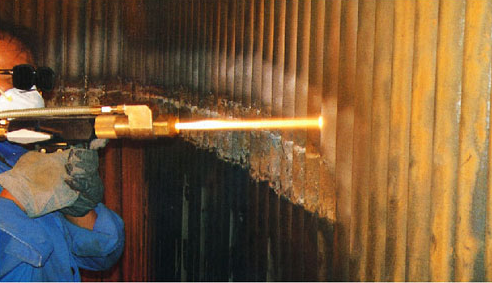1. Thermal spraying method. Thermal spraying is done to improve the properties of the substrate. It uses a certain high-temperature heat source to melt the sprayed material, atomizes it into fine droplets or high-temperature particles through a high-speed jet, and sprays it onto the surface of the pretreated substrate to form a coating technology.
1. Flame spraying. The high temperature generated by the combustion of the combustible gas is used to melt the spray material, and then the compressed air is sprayed onto the surface of the substrate at a high speed to form a coating. Supersonic flame spraying is the most widely used flame spraying technology
2. Arc spraying. Arc combustion between two continuously fed wires melts the metal, which is atomized and sprayed with compressed air to form a coating on the working surface. Features: strong versatility and high efficiency; the prepared coating has high quality, good corrosion resistance, and good bonding with the substrate; the prepared ceramic coating has good repairability.
3. Plasma spraying technology. This technology uses a direct current to generate a plasma arc to heat the sprayed material to a molten state, and spray it at a high speed to form a coating on the surface of the substrate.
Features: There are many types of sprayable materials, wide application range, high production efficiency, high-quality coatings can be prepared, little impact on the substrate, and almost no thermal deformation of the substrate.
Second, the sol-gel method. The easily hydrolyzed metal alkoxide or inorganic salt reacts with water in a certain solvent, and forms a sol through hydrolysis and polycondensation. The sol is coated on the surface of the metal substrate, and then dried and heat treated to form a coating. Advantages: It can be carried out at low temperature, and the coating quality produced is high. Disadvantages: The process is complicated, time-consuming, and the film is easy to crack.

Third, the vapor deposition method.
1. Chemical vapor deposition. It is a process that utilizes multi-element gases to chemically react on the surface of the heated part to obtain the desired coating. Advantages: When preparing the ceramic coating, it can be uniformly coated on the surface of any part with complex shape, and the obtained coating has high purity, high density and good bonding with the substrate. Disadvantages: This technique is often accompanied by harmful gases. Damage to health and the environment if not handled properly.
2. Physical vapor deposition. It refers to the process of vaporizing the coating material into atoms, molecules or ions by heating or high-energy beam bombardment under vacuum conditions, and depositing the coating on the surface of the substrate through the action of low-pressure gas or plasma. At present, the most commonly used are magnetron sputtering Radio and ion plating.
4. Self-propagating high temperature synthesis: It is a technology that uses exothermic chemical reaction of raw materials, and the reaction product is deposited on the substrate to form a coating. Advantages: simple production process, easy to use equipment; fast reaction time, short production cycle; low energy consumption; less impurities, high product purity. Disadvantages: This method requires high-purity metal powder as raw material and is not suitable for large-scale production.
5. Laser cladding technology: Using a laser beam as a heat source, the coating material coated on the surface of the substrate is melted and rapidly solidified to obtain the desired coating. Advantages: Compared with traditional coating technology, laser cladding has a very fast cooling rate in the preparation of ceramic coatings, and is non-equilibrium crystallization, which is conducive to obtaining high-strength fine-grained or even nano-crystalline structures.
Disadvantages: Laser cladding is easy to crack the coating due to strong thermal stress, and the influence of laser parameters on the quality of the coating is very complicated, so the quality of the cladding layer is difficult to control. Alumina ceramic powder is one of the ceramic raw materials. The application and preparation methods of ceramic coatings have their own advantages and disadvantages. The application of alumina ceramics in industry will become more and more diversified and will play an important role.
Note: This article is reproduced from the online platform. If there is any infringement, please contact the website staff to delete it.
